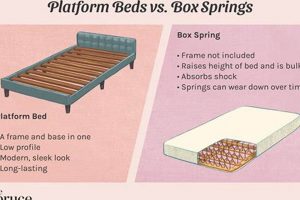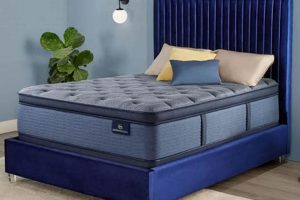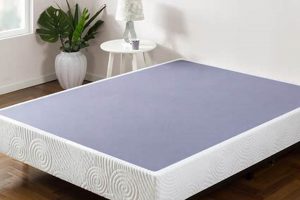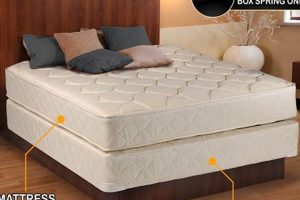The phrase refers to a mattress that has been compressed, rolled, and sealed in a box for convenient shipping and delivery. This innovative packaging method allows a full-sized bed to be transported more easily than traditional mattresses. Upon arrival, the mattress expands to its intended size and shape once the packaging is removed. As an example, a queen-sized memory foam bed can be efficiently delivered to a customer’s doorstep using this method.
This method revolutionized the bedding industry, addressing challenges associated with transporting bulky items. The reduced size and weight translate to lower shipping costs for both the manufacturer and the consumer. Furthermore, it offers enhanced convenience, eliminating the need for specialized delivery services or the difficulties of navigating narrow hallways and stairwells. The development of this packaging solution made buying a new bed more accessible and consumer-friendly.
The rise in popularity of this delivery method has spurred innovation in mattress design and materials, leading to a wider variety of options available online. Consequently, consumers now have increased access to different types of mattresses, enabling them to find the ideal bed to suit their specific needs and preferences. This accessibility has significantly impacted the mattress market, shifting a considerable portion of sales online.
Tips for Purchasing a Mattress in a Box
Considering a bed delivered in compact packaging requires careful consideration to ensure a satisfactory purchase. Adhering to these guidelines can improve the likelihood of selecting a product that meets individual needs and expectations.
Tip 1: Research Mattress Type. Different constructions offer varying levels of support, comfort, and temperature regulation. Memory foam, latex, innerspring, and hybrid models each possess unique characteristics that cater to diverse sleep preferences. Before purchasing, understand the inherent qualities of each mattress type to determine the most suitable option.
Tip 2: Scrutinize Trial Periods and Return Policies. Reputable companies typically offer a risk-free trial period, allowing customers to test the bed for an extended duration. Thoroughly examine the terms and conditions of the return policy, including any associated fees or restrictions, to ensure recourse in case of dissatisfaction.
Tip 3: Investigate Mattress Materials and Certifications. Verify that the mattress materials are CertiPUR-US certified, indicating that they meet standards for content, emissions, and durability. This certification assures consumers that the product is free from harmful chemicals and meets established safety guidelines.
Tip 4: Evaluate Online Reviews and Ratings. Customer reviews can provide valuable insights into the real-world performance and durability. Analyze a broad range of feedback, paying attention to recurring themes and concerns, to gain a comprehensive understanding of potential strengths and weaknesses.
Tip 5: Consider Edge Support. Edge support refers to the stability and reinforcement of the mattress perimeter. Insufficient edge support can lead to sagging and a reduced usable sleeping surface. Prioritize models with enhanced edge support, particularly for individuals who sleep near the edge of the bed.
Tip 6: Assess Firmness Level. Firmness is a subjective characteristic, but generally ranges from plush to extra-firm. Align the selected firmness level with individual sleep position, body weight, and personal comfort preferences. Side sleepers often prefer softer mattresses, while back and stomach sleepers may benefit from firmer options.
Tip 7: Account for Foundation Compatibility. Certain models may require specific foundation types for optimal support and longevity. Consult the manufacturer’s guidelines to ensure compatibility and avoid voiding the warranty due to improper foundation usage.
These tips aim to foster informed decision-making, empowering individuals to select a bed that aligns with their specific requirements and preferences, leading to improved sleep quality and overall satisfaction.
These considerations will allow a smooth transition into selecting other features that will compliment your bed such as bedsheets, pillows and protectors.
1. Compression
Compression is fundamental to the concept, serving as the enabling technology that allows a full-sized mattress to be packaged and shipped in a significantly smaller container. This process is not merely about reducing volume; it’s about reshaping the mattress for logistical efficiency without compromising its structural integrity or comfort properties.
- Volume Reduction
Compression technology minimizes the overall size, enabling passage through standard doorways and elevators. The decrease in cubic footage directly correlates to reduced shipping costs, affecting both the manufacturer’s operational expenses and the consumer’s final price. For instance, a traditional queen-sized mattress, which can be unwieldy to transport, becomes manageable and affordable for direct-to-consumer delivery through effective compression.
- Material Adaptability
Certain materials, such as memory foam and latex, lend themselves more effectively to compression than traditional innerspring systems. These materials possess inherent elasticity, allowing them to be tightly compacted without permanent deformation. The choice of compressible materials is a critical design consideration, influencing the type of mattress suited for this distribution model. Examples of mattresses that uses compression on adaptable material includes rolled memory foam mattresses and foldaway mattresses.
- Preservation of Mattress Integrity
The compression process must be carefully calibrated to avoid damaging the mattress’s internal structure. Excessive pressure or improper folding can lead to permanent indentations or a loss of support. Manufacturers employ sophisticated techniques to ensure uniform compression, preserving the mattress’s ability to recover to its original shape and provide adequate support upon decompression. Examples of this, quality control procedures include testing the mattress after decompression.
- Packaging Techniques
The method of compression is closely tied to the packaging materials used. Mattresses are typically compressed using specialized machinery and then sealed in airtight plastic wrapping to maintain the compressed state and protect against moisture or contaminants. The robustness of the packaging is essential for withstanding the rigors of shipping, ensuring that the mattress arrives undamaged and ready for use. Examples can be using vacuum seal and durable outer box.
In essence, compression represents the technological linchpin that makes the distribution model viable. By understanding the science and engineering behind this process, consumers can appreciate the logistical and economic advantages while ensuring they select a product that meets their comfort and support expectations.
2. Roll-packing
Roll-packing is an indispensable process that complements compression techniques, collectively enabling the efficient distribution associated with the “mattress in a box” concept. This method directly influences shipping costs, delivery logistics, and the consumer experience.
- Dimensional Reduction
The primary function of roll-packing is to further reduce the physical dimensions after compression. This involves mechanically rolling the compressed mattress into a cylindrical shape, minimizing its footprint. For example, a queen-sized mattress, already flattened through compression, is then rolled tightly, significantly decreasing its length and width for packaging.
- Enhanced Packaging Integrity
Roll-packing contributes to the structural integrity of the packaged mattress. By creating a compact, cylindrical form, the mattress is less susceptible to bending or deformation during transit. The tightly rolled structure provides inherent rigidity, protecting the inner materials from damage. For instance, edges are less likely to be crushed or warped when the mattress is rolled, compared to simply compressing and folding it.
- Automated Processing Efficiency
Roll-packing often integrates with automated assembly lines, streamlining the manufacturing and distribution process. Specialized machinery rolls the compressed mattress with precision and consistency, reducing manual labor and increasing throughput. Automation ensures uniform roll diameters and tension, contributing to efficient space utilization in shipping containers and warehouses.
- Consumer Unboxing Experience
The roll-packed state directly influences the consumer’s initial interaction with the mattress. Upon unboxing, the rolled mattress expands gradually, providing a visual representation of its decompression. This element can enhance the perceived value and novelty of the product. The unrolling process is often highlighted in marketing materials, emphasizing the convenience and ease of setup associated with bed-in-a-box products.
The integration of roll-packing significantly optimizes the logistical aspects of delivering mattresses directly to consumers. By further minimizing the packaged size and enhancing structural integrity, it enables cost-effective shipping and a streamlined unboxing experience, key elements that define the appeal of the “mattress in a box” concept.
3. Direct shipping
Direct shipping is an intrinsic component of the business model, fundamentally reshaping the traditional mattress retail landscape and providing significant advantages to both manufacturers and consumers.
- Elimination of Intermediaries
Direct shipping bypasses traditional retail channels, eliminating the need for brick-and-mortar stores and associated markups. This reduction in intermediaries results in lower prices for consumers, as the manufacturer can directly control pricing and avoid retailer commissions. For example, a mattress that might cost $1500 in a retail store could be offered for $1000 through direct shipping, due to the absence of retailer overhead.
- Expanded Geographic Reach
Direct shipping overcomes geographical limitations, enabling manufacturers to reach customers in remote areas or regions where they lack a physical presence. This expanded market access broadens the customer base and increases sales potential. A company based in California, for instance, can efficiently serve customers in Maine without incurring the expenses of establishing a physical retail location on the East Coast.
- Enhanced Customer Control
Direct shipping provides greater control over the customer experience, from order placement to delivery. Manufacturers can manage inventory, track shipments, and provide personalized customer service, fostering stronger brand loyalty. Customers can directly interact with the manufacturer’s representatives, resolving issues and receiving support without navigating multiple layers of intermediaries.
- Data-Driven Optimization
Direct shipping generates valuable data on consumer preferences, purchasing patterns, and delivery logistics. This data can be analyzed to optimize marketing strategies, improve product development, and refine supply chain management. By tracking sales data, for example, a manufacturer can identify popular models, adjust production schedules, and tailor promotions to specific customer segments.
These elements highlight how direct shipping has redefined the economics of the mattress industry, fostering greater efficiency, accessibility, and customer satisfaction. This method underscores a shift toward streamlined distribution channels and a consumer-centric approach to retail.
4. Memory foam
Memory foam plays a pivotal role in the rise of mattresses packaged and shipped in compact containers. Its unique properties directly address the logistical challenges inherent in this distribution model, enabling efficient compression and convenient delivery.
- Compressibility and Conformability
Memory foam’s viscoelastic nature allows it to be compressed significantly without permanent damage. This characteristic enables manufacturers to compress and roll the material into a smaller package for shipping. For example, a 12-inch thick memory foam mattress can be compressed to a fraction of its original size, facilitating easier transport. Upon unpacking, the material recovers its original shape and thickness, providing the intended level of comfort and support. This recoverability is essential for maintaining product quality and customer satisfaction.
- Weight Reduction
Compared to traditional innerspring mattresses, memory foam is generally lighter. This weight reduction translates to lower shipping costs, benefiting both the manufacturer and the consumer. Furthermore, the lighter weight makes it easier for consumers to handle the package upon delivery. For instance, a queen-sized memory foam mattress is often significantly lighter than a comparable innerspring model, simplifying the process of moving it into a residence.
- Motion Isolation
Memory foam excels at isolating motion, preventing disturbances from transferring across the bed. This feature is particularly appealing to couples, as it minimizes disruptions caused by a partner’s movements. In the context of a mattress delivered in a box, motion isolation becomes a key selling point, differentiating the product from older mattress technologies. For example, a couple sharing a memory foam mattress is less likely to be awakened by each other’s tossing and turning during the night.
- Pressure Relief
Memory foam conforms to the body’s contours, distributing weight evenly and reducing pressure points. This pressure relief is beneficial for individuals with joint pain or other discomforts. The ability of memory foam to alleviate pressure points contributes to improved sleep quality and overall comfort. For example, a side sleeper may experience reduced shoulder and hip pain on a memory foam mattress due to its ability to conform to the body’s shape.
In summary, the inherent properties of memory foam have made it a cornerstone of the “mattress in a box” industry. Its compressibility, weight reduction, motion isolation, and pressure relief characteristics align perfectly with the requirements of this distribution model, offering convenience, affordability, and enhanced comfort to consumers.
5. Hybrid designs
Hybrid designs represent a significant evolution within the bed-in-a-box market, addressing some limitations of purely foam-based mattresses while retaining the benefits of compressed packaging. These mattresses combine the conforming comfort of materials like memory foam or latex with the support and responsiveness of innerspring systems. The effect of this combination is a more versatile sleep surface that caters to a broader range of preferences and body types. For instance, a hybrid mattress might employ a layer of pocketed coils beneath a memory foam comfort layer, providing both contouring and robust support. This is important because it allows for a mattress that can be both comfortably conforming while still providing adequate spinal support.
The introduction of hybrid designs has expanded the bed-in-a-box market, drawing in consumers who might have previously dismissed foam mattresses as lacking traditional support. By incorporating innerspring coils, hybrid mattresses often offer improved airflow compared to all-foam models, addressing concerns about overheating during sleep. Furthermore, the edge support in hybrid designs is often superior to all-foam alternatives, providing a more stable sleeping surface and preventing the sensation of rolling off the bed. Practical applications of this understanding are evident in the increasing availability of hybrid mattresses from online retailers, signaling a shift in consumer demand toward more versatile and supportive bed-in-a-box options.
In summary, hybrid designs have become a crucial component of the bed-in-a-box market, bridging the gap between traditional innerspring mattresses and the convenience of compressed packaging. While challenges remain in optimizing the compression process for hybrid models, their increasing popularity demonstrates the value of combining different materials to create a more satisfying sleep experience. This evolution ensures that the bed-in-a-box category continues to adapt to consumer needs and preferences, solidifying its position as a viable alternative to conventional mattress shopping.
6. Convenient delivery
The concept relies significantly on the component of convenient delivery, serving as a primary driver behind consumer adoption. Traditional mattress purchasing often involves scheduling delivery appointments, navigating transportation logistics, and potentially requiring assistance with moving a bulky, unwieldy item. The ability to have a mattress delivered directly to one’s doorstep in a manageable box eliminates these hassles. For example, individuals residing in apartment buildings or those with limited transportation options find this delivery method particularly appealing. This increased convenience directly addresses a major pain point in the mattress buying experience.
The implementation streamlines the entire process, reducing the need for extensive coordination and specialized equipment. The compressed packaging allows for standard shipping methods, such as those employed by major carriers like UPS or FedEx, to be utilized. This efficiency translates to faster delivery times and reduced shipping costs for both the manufacturer and the consumer. Consider a scenario where a customer orders a mattress online and receives it within a few days, without needing to schedule a specific delivery window or arrange for assistance in moving the item. This contrasts sharply with the often protracted and complicated delivery processes associated with traditional mattress retailers.
Understanding the practical significance highlights a shift in consumer expectations toward greater convenience and accessibility in retail experiences. While the quality and comfort of the mattress remain paramount, the ease of delivery is a major factor influencing purchasing decisions. Challenges may arise in ensuring timely and damage-free delivery, particularly during peak seasons, but the overall impact of convenient delivery on the success of the concept cannot be overstated. This aspect, coupled with online accessibility and competitive pricing, has contributed significantly to the widespread adoption of this business model and its impact on the mattress industry as a whole.
7. Simplified setup
Simplified setup is intrinsically linked to the mattress-in-a-box concept. The design of compressing and packaging a mattress is directly motivated by the objective of facilitating a straightforward and manageable setup process for the end user. This contrasts with the conventional challenges associated with maneuvering a full-sized mattress, often requiring multiple individuals and specialized equipment. The core benefit of this delivery method is a streamlined unboxing and expansion process, minimizing the physical effort and time investment required from the consumer.
The unpacking procedure typically involves removing the mattress from its box, carefully cutting away the protective plastic wrapping, and allowing the compressed mattress to expand to its full size over a period of hours. This process generally requires no specialized tools or expertise. An individual can complete the setup independently, eliminating the need to schedule professional installation or enlist assistance from others. A practical example is the ease with which a single person can set up a king-size mattress in a second-floor apartment, a scenario that would pose considerable difficulty with a traditional, non-compressed mattress.
The ease of setup contributes significantly to the overall appeal and marketability of the concept. It addresses a key consumer pain point, providing a convenient and hassle-free alternative to traditional mattress shopping and delivery. While factors such as mattress quality and pricing are crucial, the simplified setup is a significant differentiating factor, underscoring the value proposition of the mattress-in-a-box business model. Though the expansion period requires patience, the overall reduction in effort and complexity represents a tangible benefit for consumers.
Frequently Asked Questions
This section addresses common queries and concerns related to mattresses delivered in compressed packaging, offering clear and concise answers to facilitate informed decision-making.
Question 1: Does compressing a mattress damage its internal structure?
The compression process, when executed correctly by manufacturers, should not compromise the long-term integrity of the mattress. Materials like memory foam and latex are inherently resilient and designed to withstand compression. However, prolonged storage in a compressed state could potentially affect performance. It is generally advisable to unbox the mattress promptly after delivery.
Question 2: How long does a compressed mattress take to fully expand?
Expansion times vary depending on the mattress type and manufacturer’s specifications. Typically, a mattress will expand to approximately 90% of its intended size within a few hours. However, full expansion may take up to 24-72 hours. Temperature and humidity can also influence the expansion rate. Consult the manufacturer’s instructions for specific guidance.
Question 3: Are all mattress types suitable for compression and roll-packing?
Certain mattress types are more amenable to compression than others. Memory foam and latex mattresses are well-suited due to their inherent flexibility and resilience. Hybrid mattresses, which combine foam with innerspring coils, can also be compressed, but the coil system may limit the degree of compression achievable. Traditional innerspring mattresses are generally not suitable for this packaging method.
Question 4: Does a compressed mattress offer the same level of support as a traditional mattress?
The level of support offered by a compressed mattress depends on its internal construction and materials. High-density memory foam and well-designed hybrid models can provide comparable support to traditional mattresses. However, it is essential to research specific mattress models and read customer reviews to assess their support characteristics.
Question 5: What should be done if a compressed mattress fails to fully expand?
If a mattress fails to fully expand within the recommended timeframe, consult the manufacturer’s instructions and contact their customer support. Ensure the mattress is placed on a proper foundation and that the room temperature is within an acceptable range. In some cases, gently massaging the mattress may help to expedite the expansion process.
Question 6: Are there any health concerns associated with off-gassing from a compressed mattress?
Some compressed mattresses, particularly those containing polyurethane foam, may emit volatile organic compounds (VOCs), resulting in a noticeable odor known as off-gassing. This odor is generally harmless and dissipates within a few days. Look for mattresses with CertiPUR-US certification, which indicates that the foam has been tested for harmful emissions.
In summation, purchasing necessitates careful deliberation and awareness of potential challenges. By understanding the properties of various materials, reading reviews, and heeding the advice of experts consumers can ensure that their investment is worthwhile.
This information provides a foundation for understanding the benefits and limitations, facilitating better decision-making. Proceed to additional resources for in-depth information on specific models and brands.
Conclusion
This exploration has clarified what does mattress in a box mean, revealing it as a confluence of compression technology, efficient logistics, and evolving material science. The phrase represents a fundamental shift in how mattresses are manufactured, distributed, and ultimately, experienced by consumers. Its accessibility and convenience stem from optimized packaging, streamlined shipping, and simplified setup, creating a paradigm that contrasts sharply with traditional retail models.
The implications of this industry innovation extend beyond mere convenience. The shift towards online sales and direct-to-consumer models empowers consumers with greater choice, price transparency, and access to detailed product information. As the mattress market continues to evolve, understanding the technological and logistical underpinnings of “what does mattress in a box mean” will be crucial for navigating an increasingly complex landscape and making informed purchasing decisions that align with individual needs and preferences.





![Best Box Spring & Mattress Queen Set [Deals!] Organic & Natural Mattress Buyer’s Guide: Non-Toxic Sleep Solutions Best Box Spring & Mattress Queen Set [Deals!] | Organic & Natural Mattress Buyer’s Guide: Non-Toxic Sleep Solutions](https://mattressworldpa.com/wp-content/uploads/2025/07/th-3396-300x200.jpg)

![Best California King Mattress With Box Spring [Guide] Organic & Natural Mattress Buyer’s Guide: Non-Toxic Sleep Solutions Best California King Mattress With Box Spring [Guide] | Organic & Natural Mattress Buyer’s Guide: Non-Toxic Sleep Solutions](https://mattressworldpa.com/wp-content/uploads/2025/07/th-3394-300x200.jpg)